Molecules and Chemistry in Red Supergiants
Abstract
1. Introduction: Circumstellar Chemistry Beyond the Asymptotic Giant Branch
2. The Molecular Inventory of the Envelopes of RSGs
3. The Surprising Variation in Spatial Distributions of Molecules
4. The Unusual Chemistry in RSGs
4.1. An Overview of Abundances
| Molecule | VY CMa b | NML Cyg c | IRC+10420 d | O-Rich AGB e |
|---|---|---|---|---|
| CO | ∼ | (1–5) × | ||
| HCN | (1–8) × | ≥ | (0.9–9) × | |
| HNC | − | |||
| CN | (0.002–2) × | |||
| SO | ||||
| O | 2.4 × f | > g | − | (1–2) × k |
| h | ≥ | (2–10) × | ||
| − | − | − | ||
| CS | (0.07–8) × | |||
| SiO | ∼ | ≥ | (0.04–2) × | |
| SiS | (0.001-1) × | |||
| S | − | (0.04–2.5) × | ||
| NaCl | − | (0.05–3) × | ||
| PN | (1–2) × i | |||
| PO | i | − | (0.5–1) × i | |
| NO | ∼ | − | − | |
| NS | ||||
| j | 2 × | 5 × | (2–5) × | − |
| AlO | ∼ | − | (4–8) × l | |
| AlOH | − | − | (2–4) × l | |
| TiO k | − | − | ∼ | |
| k | − | − | ||
| VO | ∼ | − | − | − |
| KCl | − | − | − | |
| AlCl | ∼ | − | − | (0.1–2) × l |
4.2. The Role of LTE Formation
4.3. Influence of Shocks
4.4. Chemical Formation of Phosphorus Nitride: Mass Loss, Shocks, and Convective Mixing
5. Molecules, Isotopes and Nucleosynthesis
| 12C/13C | 16O/18O | 35Cl/37Cl | 32S/34S | 28Si/29Si | 28Si/30Si | 29Si/30Si | |
|---|---|---|---|---|---|---|---|
| VY CMa a | 22–38 f 25–46 f | – | – | – | – | – | |
| NML Cyg b | ; 17; | >250; | ; | ; | ; | ||
| VX Sgr c | – | – | – | – | – | – | |
| RGS d | 7–17 ± 4 | 550 ± 150 | – | – | – | – | – |
| Solar e | 89 | 500 | 3.13 | 25 | 20 | 29 | 1.5 |
6. Molecular Masers in RSGs
6.1. Types of Masers in RSGs
6.2. Masers Tracing Wind Conditions
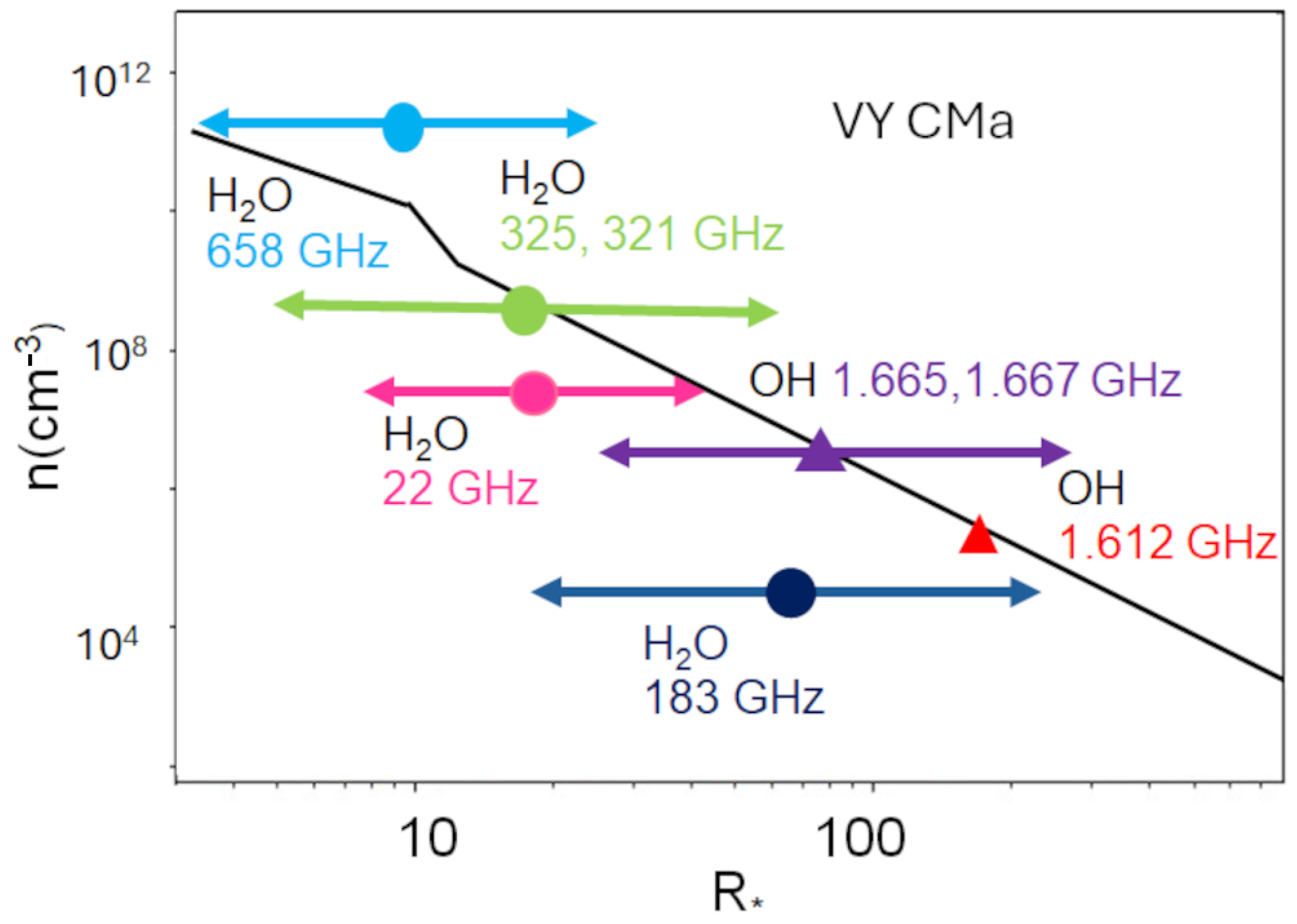
7. Prospectus
Author Contributions
Funding
Acknowledgments
Conflicts of Interest
Abbreviations
| AGB | Asymptotic Giant Branch |
| ALMA | Atacama Large Millimeter/sub-millimetre Array |
| ARO SMT | Arizona Observatory Sub-Millimeter Telescope |
| CSE | Circumstellar Envelope |
| E-AGB | Early-AGB |
| HST | Hubble Space Telescope |
| IRAM | Institute de Radioastronomie Millimetrique |
| ISM | Interstellar Medium |
| JBCA | Jodrell Bank Centre for Astrophysics |
| LSR | Local Standard of Rest (kinematic) velocity frame |
| LTE | Local Thermodynamic Equillibrium |
| MERLIN | Multi Element Radio Interferometry Network |
| r | Radial separation from star |
| Gas pressure [51] | |
| Stellar radius (optical/IR) | |
| RGB | Red Giant Branch |
| RSG | Red Supergiant |
| SMA | Sub-Millimetre Array |
| SNe | Supernovae |
| Gas Temperature | |
| Kinetic Temperature | |
| Stellar temperature | |
| TP-AGB | Thermal Pulse-AGB |
| U-lines | Unidentified lines |
| VLBA | Very Long Baseline Array |
| VLBA | Very Long Baseline Interferometry |
| v | Stellar wind expansion velocity or vibrational state |
| Stellar wind velocity | |
| YHG | Yellow Hypergiant (RSG) |
References
- Höfner, S.; Olofsson, H. Mass loss of stars on the asymptotic giant branch. Mechanisms, models and measurements. Astron. Astrophys. Rev. 2018, 26, 1. [Google Scholar] [CrossRef]
- Ziurys, L.M. Interstellar Chemistry Special Feature: The chemistry in circumstellar envelopes of evolved stars: Following the origin of the elements to the origin of life. Proc. Natl. Acad. Sci. USA 2006, 103, 12274–12279. [Google Scholar] [CrossRef] [PubMed]
- Schöier, F.L.; Olofsson, H. Models of circumstellar molecular radio line emission. Mass loss rates for a sample of bright carbon stars. Astron. Astrophys. 2001, 368, 969–993. [Google Scholar] [CrossRef]
- Keady, J.J.; Hall, D.N.B.; Ridgway, S.T. The IRC +10216 Circumstellar Envelope. I. Models for the Dust and Gas. Astrophys. J. 1988, 326, 832. [Google Scholar] [CrossRef]
- Herwig, F. Evolution of Asymptotic Giant Branch Stars. Annu. Rev. Astron. Astrophys. 2005, 43, 435–479. [Google Scholar] [CrossRef]
- Glassgold, A.E. Circumstellar Photochemistry. Annu. Rev. Astron. Astrophys. 1996, 34, 241–278. [Google Scholar] [CrossRef]
- Milam, S.N.; Woolf, N.J.; Ziurys, L.M. Circumstellar 12C/13C Isotope Ratios from Millimeter Observations of CN and CO: Mixing in Carbon- and Oxygen-Rich Stars. Astrophys. J. 2009, 690, 837–849. [Google Scholar] [CrossRef]
- Tenenbaum, E.D.; Dodd, J.L.; Milam, S.N.; Woolf, N.J.; Ziurys, L.M. The Arizona Radio Observatory 1 mm Spectral Survey of IRC +10216 and VY Canis Majoris (215–285 GHz). Astrophys. J. Suppl. Ser. 2010, 190, 348–417. [Google Scholar] [CrossRef]
- Levesque, E.M. Astrophysics of Red Supergiants; IOP Publishing: Bristol, UK, 2017. [Google Scholar] [CrossRef]
- Humphreys, R.M.; Jones, T.J. Episodic Gaseous Outflows and Mass Loss from Red Supergiants. Astron. J. 2022, 163, 103. [Google Scholar] [CrossRef]
- Smartt, S.J. Observational Constraints on the Progenitors of Core-Collapse Supernovae: The Case for Missing High-Mass Stars. Publ. Astron. Soc. Aust. 2015, 32, e016. [Google Scholar] [CrossRef]
- Rodríguez, Ó. Luminosity distribution of Type II supernova progenitors. Mon. Not. R. Astron. Soc. 2022, 515, 897–913. [Google Scholar] [CrossRef]
- Beasor, E.R.; Smith, N.; Jencson, J.E. The Red Supergiant Progenitor Luminosity Problem. Astrophys. J. 2025, 979, 117. [Google Scholar] [CrossRef]
- Sukhbold, T.; Woosley, S.E.; Heger, A. A High-resolution Study of Presupernova Core Structure. Astrophys. J. 2018, 860, 93. [Google Scholar] [CrossRef]
- Humphreys, R.M.; Helton, L.A.; Jones, T.J. The Three-Dimensional Morphology of VY Canis Majoris. I. The Kinematics of the Ejecta. Astron. J. 2007, 133, 2716–2729. [Google Scholar] [CrossRef]
- Humphreys, R.M.; Davidson, K.; Richards, A.M.S.; Ziurys, L.M.; Jones, T.J.; Ishibashi, K. The Mass-loss History of the Red Hypergiant VY CMa. Astron. J. 2021, 161, 98. [Google Scholar] [CrossRef]
- Quintana-Lacaci, G.; Velilla-Prieto, L.; Agúndez, M.; Fonfría, J.P.; Cernicharo, J.; Decin, L.; Castro-Carrizo, A. History of two mass loss processes in VY CMa. Fast outflows carving older ejecta. Astron. Astrophys. 2023, 669, A56. [Google Scholar] [CrossRef]
- Singh, A.P.; Richards, A.M.S.; Humphreys, R.M.; Decin, L.; Ziurys, L.M. ALMA Reveals Hidden Morphologies in the Molecular Envelope of VY Canis Majoris. Astrophys. J. Lett. 2023, 954, L1. [Google Scholar] [CrossRef]
- Ziurys, L.M.; Tenenbaum, E.D.; Pulliam, R.L.; Woolf, N.J.; Milam, S.N. Carbon Chemistry in the Envelope of VY Canis Majoris: Implications for Oxygen-Rich Evolved Stars. Astrophys. J. 2009, 695, 1604–1613. [Google Scholar] [CrossRef]
- Kim, H.; Wyrowski, F.; Menten, K.M.; Decin, L. Circumstellar molecular composition of the oxygen-rich AGB star IK Tauri. I. Observations and LTE chemical abundance analysis. Astron. Astrophys. 2010, 516, A68. [Google Scholar] [CrossRef]
- Omont, A.; Lucas, R.; Morris, M.; Guilloteau, S. S-bearing molecules in O-rich circumstellar envelopes. Astron. Astrophys. 1993, 267, 490–514. [Google Scholar]
- Bachiller, R.; Fuente, A.; Bujarrabal, V.; Colomer, F.; Loup, C.; Omont, A.; de Jong, T. A survey of CN in circumstellar envelopes. Astron. Astrophys. 1997, 319, 235–243. [Google Scholar]
- Bujarrabal, V.; Fuente, A.; Omont, A. Molecular observations of O- and C-rich circumstellar envelopes. Astron. Astrophys. 1994, 285, 247–271. [Google Scholar]
- Anderson, J.K.; Ziurys, L.M. Detection of CCN (x 2πr) in IRC+10216: Constraining Carbon-chain Chemistry. Astrophys. J. Lett. 2014, 795, L1. [Google Scholar] [CrossRef]
- Tenenbaum, E.D.; Dodd, J.L.; Milam, S.N.; Woolf, N.J.; Ziurys, L.M. Comparative Spectra of Oxygen-rich Versus Carbon-rich Circumstellar Shells: VY Canis Majoris and IRC +10216 at 215–285 GHz. Astrophys. J. Lett. 2010, 720, L102–L107. [Google Scholar] [CrossRef]
- Tenenbaum, E.D.; Woolf, N.J.; Ziurys, L.M. Identification of Phosphorus Monoxide (X2Πr) in VY Canis Majoris: Detection of the First PO Bond in Space. Astrophys. J. Lett. 2007, 666, L29–L32. [Google Scholar] [CrossRef]
- Tenenbaum, E.D.; Ziurys, L.M. Millimeter Detection of AlO (X 2Σ+): Metal Oxide Chemistry in the Envelope of VY Canis Majoris. Astrophys. J. Lett. 2009, 694, L59–L63. [Google Scholar] [CrossRef]
- Tenenbaum, E.D.; Ziurys, L.M. Exotic Metal Molecules in Oxygen-rich Envelopes: Detection of AlOH (X1Σ+) in VY Canis Majoris. Astrophys. J. Lett. 2010, 712, L93–L97. [Google Scholar] [CrossRef]
- Ziurys, L.M.; Milam, S.N.; Apponi, A.J.; Woolf, N.J. Chemical complexity in the winds of the oxygen-rich supergiant star VY Canis Majoris. Nature 2007, 447, 1094–1097. [Google Scholar] [CrossRef]
- Kamiński, T.; Gottlieb, C.A.; Menten, K.M.; Patel, N.A.; Young, K.H.; Brünken, S.; Müller, H.S.P.; McCarthy, M.C.; Winters, J.M.; Decin, L. Pure rotational spectra of TiO and TiO2 in VY Canis Majoris. Astron. Astrophys. 2013, 551, A113. [Google Scholar] [CrossRef]
- Humphreys, R.M.; Ziurys, L.M.; Bernal, J.J.; Gordon, M.S.; Helton, L.A.; Ishibashi, K.; Jones, T.J.; Richards, A.M.S.; Vlemmings, W. The Unexpected Spectrum of the Innermost Ejecta of the Red Hypergiant VY CMa. Astrophys. J. Lett. 2019, 874, L26. [Google Scholar] [CrossRef]
- Wallerstein, G. Spectroscopic Observations of VY Canis Majoris during 1969–1971. Astrophys. J. 1971, 169, 195. [Google Scholar] [CrossRef]
- Teyssier, D.; Quintana-Lacaci, G.; Marston, A.P.; Bujarrabal, V.; Alcolea, J.; Cernicharo, J.; Decin, L.; Dominik, C.; Justtanont, K.; de Koter, A.; et al. Herschel/HIFI observations of red supergiants and yellow hypergiants. I. Molecular inventory. Astron. Astrophys. 2012, 545, A99. [Google Scholar] [CrossRef]
- Kamiński, T.; Gottlieb, C.A.; Young, K.H.; Menten, K.M.; Patel, N.A. An Interferometric Spectral Line and Imaging Survey of VY Canis Majoris in the 345 GHz Band. Astrophys. J. Suppl. Ser. 2013, 209, 38. [Google Scholar] [CrossRef]
- Quintana-Lacaci, G.; Agúndez, M.; Cernicharo, J.; Bujarrabal, V.; Sánchez Contreras, C.; Castro-Carrizo, A.; Alcolea, J. A λ 3 mm and 1 mm line survey toward the yellow hypergiant IRC +10420. N-rich chemistry and IR flux variations. Astron. Astrophys. 2016, 592, A51. [Google Scholar] [CrossRef]
- Wallström, S.H.J.; Danilovich, T.; Müller, H.S.P.; Gottlieb, C.A.; Maes, S.; Van de Sande, M.; Decin, L.; Richards, A.M.S.; Baudry, A.; Bolte, J.; et al. ATOMIUM: Molecular inventory of 17 oxygen-rich evolved stars observed with ALMA. Astron. Astrophys. 2024, 681, A50. [Google Scholar] [CrossRef]
- Ravi, R.; Singh, A.P.; Richards, A.M.S.; Humphreys, R.M.; Decin, L.; Ziurys, L.M. PO and PN in the Envelope of VY Canis Majoris: Elucidating the Chemistry and Origin of Phosphorus. Astrophys. J. Lett. 2024, 971, L43. [Google Scholar] [CrossRef]
- Singh, A.P.; Edwards, J.L.; Ziurys, L.M. The Arizona Radio Observatory 1 mm Spectral Survey of the Hypergiant Star NML Cygni (215–285 GHz). Astron. J. 2022, 164, 230. [Google Scholar] [CrossRef]
- Singh, A.P.; Edwards, J.L.; Humphreys, R.M.; Ziurys, L.M. Molecules and Outflows in NML Cygni: New Insights from a 1 mm Spectral Line Survey. Astrophys. J. Lett. 2021, 920, L38. [Google Scholar] [CrossRef]
- Kervella, P.; Decin, L.; Richards, A.M.S.; Harper, G.M.; McDonald, I.; O’Gorman, E.; Montargès, M.; Homan, W.; Ohnaka, K. The close circumstellar environment of Betelgeuse. V. Rotation velocity and molecular envelope properties from ALMA. Astron. Astrophys. 2018, 609, A67. [Google Scholar] [CrossRef]
- Knapp, G.R.; Woodhams, M. Mass Loss from Cool Supergiant Stars. In Massive Stars: Their Lives in the Interstellar Medium; Cassinelli, J.P., Churchwell, E.B., Eds.; Astronomical Society of the Pacific Conference Series; Astronomical Society of the Pacific: San Francisco, CA, USA, 1993; Volume 35, p. 199. [Google Scholar]
- Quintana-Lacaci, G.; Cernicharo, J.; Bujarrabal, V.; Castro-Carrizo, A.; Sanchez-Contreras, C.; Agundez, M.; Alcolea, J. Properties of the molecular gas around the most massive evolved stars. In Proceedings of the Asymmetrical Planetary Nebulae VI Conference, Riviera Maya, Mexico, 4–8 November 2013; Morisset, C., Delgado-Inglada, G., Torres-Peimbert, S., Eds.; p. 72. [Google Scholar]
- Velilla Prieto, L.; Sánchez Contreras, C.; Cernicharo, J.; Agúndez, M.; Quintana-Lacaci, G.; Bujarrabal, V.; Alcolea, J.; Balança, C.; Herpin, F.; Menten, K.M.; et al. The millimeter IRAM-30 m line survey toward IK Tauri. Astron. Astrophys. 2017, 597, A25. [Google Scholar] [CrossRef]
- Shenoy, D.; Humphreys, R.M.; Jones, T.J.; Marengo, M.; Gehrz, R.D.; Helton, L.A.; Hoffmann, W.F.; Skemer, A.J.; Hinz, P.M. Searching for Cool Dust in the Mid-to-far Infrared: The Mass-loss Histories of the Hypergiants μ Cep, VY CMa, IRC+10420, and ρ Cas. Astron. J. 2016, 151, 51. [Google Scholar] [CrossRef]
- Gahm, G.F.; Hultqvist, L. On the presence of lithium in S Persei, a late M supergiant with OH and H2O emission. Astron. Astrophys. 1976, 50, 153–155. [Google Scholar]
- Gordon, M.S.; Humphreys, R.M.; Jones, T.J.; Shenoy, D.; Gehrz, R.D.; Helton, L.A.; Marengo, M.; Hinz, P.M.; Hoffmann, W.F. Searching for Cool Dust. II. Infrared Imaging of The OH/IR Supergiants, NML Cyg, VX Sgr, S Per, and the Normal Red Supergiants RS Per and T Per. Astron. J. 2018, 155, 212. [Google Scholar] [CrossRef]
- Danilovich, T.; Richards, A.M.S.; Decin, L.; Van de Sande, M.; Gottlieb, C.A. An ALMA view of SO and SO2 around oxygen-rich AGB stars. Mon. Not. R. Astron. Soc. 2020, 494, 1323–1347. [Google Scholar] [CrossRef]
- Khouri, T.; Vlemmings, W.H.T.; Olofsson, H.; Ginski, C.; De Beck, E.; Maercker, M.; Ramstedt, S. High-resolution observations of gas and dust around Mira using ALMA and SPHERE/ZIMPOL. Astron. Astrophys. 2018, 620, A75. [Google Scholar] [CrossRef]
- Siebert, M.A.; Simon, I.; Shingledecker, C.N.; Carroll, P.B.; Burkhardt, A.M.; Booth, S.T.; Remijan, A.J.; McGuire, B.A.; Aladro, R.; Duran, C.A. A Search for Light Hydrides in the Envelopes of Evolved Stars. Astrophys. J. 2020, 901, 22. [Google Scholar] [CrossRef]
- Ravi, R.; Humphreys, R.M.; Ziurys, L.M.; Richards, A.M.S. Aluminum Chemistry in VY CMa: An ALMA Perspective. Astrophys. J. 2025. submitted. [Google Scholar]
- Tsuji, T. Molecular abundances in stellar atmospheres. II. Astron. Astrophys. 1973, 23, 411. [Google Scholar]
- Humphreys, R.M.; Jones, T.J.; Davidson, K.; Richards, A.M.S.; Ravi, R.; Singh, A.P.; Ziurys, L.M. The Infrared-bright SW Knots in the Complex Ejecta of VY CMa. Astron. J. 2025, 169, 230. [Google Scholar] [CrossRef]
- Menten, K.M.; Alcolea, J. Detection of Ammonia Emission toward Oxygen-rich Evolved Stars. Astrophys. J. 1995, 448, 416. [Google Scholar] [CrossRef]
- Audouze, J.; Truran, J.W.; Zimmerman, B.A. Hot CNO-Ne Cycle Hydrogen Burning. Thermonuclear Evolution at Constant Temperature and Density. Astrophys. J. 1973, 184, 493–516. [Google Scholar] [CrossRef]
- Ravi, R.; Richards, A.M.S.; Humphreys, R.M.; Ziurys, L.M. A Limited 1 mm ALMA Spectral Line Survey of VY CMa. Astrophys. J. 2025. submitted. [Google Scholar]
- Dinh-V-Trung; tat Wong, K.; Lim, J. Dense Molecular Clumps in the Envelope of the Yellow Hypergiant IRC+10420. Astrophys. J. 2017, 851, 65. [Google Scholar] [CrossRef]
- Richards, A.M.S.; Diamond, P.J.; Bayo, A.; Sierra, M.; García-Lario, P.; Osuna, P.; Padovani, P.; Rosati, P.; Allen, M.G.; Derriere, S.; et al. Hunting post-AGB/RSG objects using Virtual Observatories and other internet-based technology. Mem.-Soc. Astron. Ital. 2005, 76, 467. [Google Scholar]
- Decin, L.; Richards, A.M.S.; Millar, T.J.; Baudry, A.; De Beck, E.; Homan, W.; Smith, N.; Van de Sande, M.; Walsh, C. ALMA-resolved salt emission traces the chemical footprint and inner wind morphology of VY Canis Majoris. Astron. Astrophys. 2016, 592, A76. [Google Scholar] [CrossRef]
- Adande, G.R.; Edwards, J.L.; Ziurys, L.M. Sulfur Chemistry in the Envelope of VY Canis Majoris: Detailed Analysis of SO and SO2 Emission. Astrophys. J. 2013, 778, 22. [Google Scholar] [CrossRef]
- Ziurys, L.M.; Friberg, P.; Irvine, W.M. Interstellar SiO as a Tracer of High-Temperature Chemistry. Astrophys. J. 1989, 343, 201. [Google Scholar] [CrossRef]
- Decin, L.; Hony, S.; de Koter, A.; Justtanont, K.; Tielens, A.G.G.M.; Waters, L.B.F.M. Probing the mass-loss history of AGB and red supergiant stars from CO rotational line profiles. I. Theoretical model–Mass-loss history unravelled in VY CMa. Astron. Astrophys. 2006, 456, 549–563. [Google Scholar] [CrossRef]
- Willacy, K.; Cherchneff, I. Silicon and Sulfur in the Inner Wind of IRC+10216. Astron. Astrophys. 1998, 330, 676. [Google Scholar]
- Pulliam, R.L.; Edwards, J.L.; Ziurys, L.M. Circumstellar Ion-Molecule Chemistry: Observations of HCO+ in the Envelopes of O-rich Stars and IRC+10216. Astrophys. J. 2011, 743, 36. [Google Scholar] [CrossRef]
- Neufeld, D.A.; Menten, K.M.; Durán, C.; Güsten, R.; Kaufman, M.J.; Kraus, A.; Mazumdar, P.; Melnick, G.J.; Ortiz-León, G.N.; Wiesemeyer, H.; et al. Terahertz Water Masers. II. Further SOFIA/GREAT Detections Toward Circumstellar Outflows, and a Multitransition Analysis. Astrophys. J. 2021, 907, 42. [Google Scholar] [CrossRef]
- Zubko, V.; Li, D.; Lim, T.; Feuchtgruber, H.; Harwit, M. Observations of Water Vapor Outflow from NML Cygnus. Astrophys. J. 2004, 610, 427–435. [Google Scholar] [CrossRef]
- Ziurys, L.M.; Schmidt, D.R.; Bernal, J.J. New Circumstellar Sources of PO and PN: The Increasing Role of Phosphorus Chemistry in Oxygen-rich Stars. Astrophys. J. 2018, 856, 169. [Google Scholar] [CrossRef]
- Danilovich, T.; Gottlieb, C.A.; Decin, L.; Richards, A.M.S.; Lee, K.L.K.; Kamiński, T.; Patel, N.A.; Young, K.H.; Menten, K.M. Rotational Spectra of Vibrationally Excited AlO and TiO in Oxygen-rich Stars. Astrophys. J. 2020, 904, 110. [Google Scholar] [CrossRef]
- De Beck, E.; Decin, L.; Ramstedt, S.; Olofsson, H.; Menten, K.M.; Patel, N.A.; Vlemmings, W.H.T. Search for aluminium monoxide in the winds of oxygen-rich AGB stars. Astron. Astrophys. 2017, 598, A53. [Google Scholar] [CrossRef]
- Wittkowski, M.; Hauschildt, P.H.; Arroyo-Torres, B.; Marcaide, J.M. Fundamental properties and atmospheric structure of the red supergiant VY Canis Majoris based on VLTI/AMBER spectro-interferometry. Astron. Astrophys. 2012, 540, L12. [Google Scholar] [CrossRef]
- Lodders, K. Solar System Abundances and Condensation Temperatures of the Elements. Astrophys. J. 2003, 591, 1220–1247. [Google Scholar] [CrossRef]
- Agundez, M.; Martinez, J.I.; de Andres, P.L.; Cernicharo, J.; Martin-Gago, J.A. Chemical equilibrium in AGB atmospheres: Successes, failures, and prospects for small molecules, clusters, and condensates. Astron. Astrophys. 2020, 637, A59. [Google Scholar] [CrossRef]
- Cherchneff, I. A chemical study of the inner winds of asymptotic giant branch stars. Astron. Astrophys. 2006, 456, 1001–1012. [Google Scholar] [CrossRef]
- Lodders, K.; Fegley, B., Jr. Condensation Chemistry of Circumstellar Grains. In International Astronomical Union Symposium Asymptotic Giant Branch Stars; Le Bertre, T., Lebre, A., Waelkens, C., Eds.; Cambridge University Press: Cambridge, UK, 1999; Volume 191, p. 279. [Google Scholar]
- Monnier, J.D.; Bester, M.; Danchi, W.C.; Johnson, M.A.; Lipman, E.A.; Townes, C.H.; Tuthill, P.G.; Geballe, T.R.; Nishimoto, D.; Kervin, P.W. Nonuniform Dust Outflow Observed around Infrared Object NML Cygni. Astrophys. J. 1997, 481, 420–432. [Google Scholar] [CrossRef]
- Lodders, K.; Amari, S. Presolar grains from meteorites: Remnants from the early times of the solar system. Chem. Erde Geochem. 2005, 65, 93–166. [Google Scholar] [CrossRef]
- Velilla-Prieto, L.; Cernicharo, J.; Agúndez, M.; Fonfría, J.P.; Quintana-Lacaci, G.; Marcelino, N.; Castro-Carrizo, A. IRC + 10°216 mass loss properties through the study of λ3 mm emission. Large spatial scale distribution of SiO, SiS, and CS. Astron. Astrophys. 2019, 629, A146. [Google Scholar] [CrossRef]
- Cherchneff, I. The inner wind of IRC+10216 revisited: New exotic chemistry and diagnostic for dust condensation in carbon stars. Astron. Astrophys. 2012, 545, A12. [Google Scholar] [CrossRef]
- Agúndez, M.; Fonfría, J.P.; Cernicharo, J.; Kahane, C.; Daniel, F.; Guélin, M. Molecular abundances in the inner layers of IRC +10216. Astron. Astrophys. 2012, 543, A48. [Google Scholar] [CrossRef]
- Aota, T.; Aikawa, Y. Phosphorus Chemistry in the Shocked Region L1157 B1. Astrophys. J. 2012, 761, 74. [Google Scholar] [CrossRef]
- Jiménez-Serra, I.; Viti, S.; Quénard, D.; Holdship, J. The Chemistry of Phosphorus-bearing Molecules under Energetic Phenomena. Astrophys. J. 2018, 862, 128. [Google Scholar] [CrossRef]
- Lefloch, B.; Vastel, C.; Viti, S.; Jimenez-Serra, I.; Codella, C.; Podio, L.; Ceccarelli, C.; Mendoza, E.; Lepine, J.R.D.; Bachiller, R. Phosphorus-bearing molecules in solar-type star-forming regions: First PO detection. Mon. Not. R. Astron. Soc. 2016, 462, 3937–3944. [Google Scholar] [CrossRef]
- Danilovich, T.; Malfait, J.; Van de Sande, M.; Montargès, M.; Kervella, P.; De Ceuster, F.; Coenegrachts, A.; Millar, T.J.; Richards, A.M.S.; Decin, L.; et al. Chemical tracers of a highly eccentric AGB-main-sequence star binary. Nat. Astron. 2024, 8, 308–327. [Google Scholar] [CrossRef]
- Danilovich, T.; Richards, A.M.S.; Van de Sande, M.; Gottlieb, C.A.; Millar, T.J.; Karakas, A.I.; Müller, H.S.P.; Justtanont, K.; Plane, J.M.C.; Etoka, S.; et al. The salty emission of the intermediate-mass AGB star OH 30.1-0.7. Mon. Not. R. Astron. Soc. 2025, 536, 684–713. [Google Scholar] [CrossRef]
- Andrews, H.; De Beck, E.; Hirvonen, P. Multiple components in the molecular outflow of the red supergiant NML Cyg. Mon. Not. R. Astron. Soc. 2022, 510, 383–398. [Google Scholar] [CrossRef]
- Bertulani, C.A.; Kajino, T. Frontiers in nuclear astrophysics. Prog. Part. Nucl. Phys. 2016, 89, 56–100. [Google Scholar] [CrossRef]
- Harris, M.J.; Lambert, D.L. Oxygen isotopic abundances in the atmospheres of seven red giant stars. Astrophys. J. 1984, 285, 674–682. [Google Scholar] [CrossRef]
- Asplund, M.; Grevesse, N.; Sauval, A.J.; Scott, P. The Chemical Composition of the Sun. Annu. Rev. Astron. Astrophys. 2009, 47, 481–522. [Google Scholar] [CrossRef]
- Elitzur, M.; Hollenbach, D.J.; McKee, C.F. Planar H2O Masers in Star-forming Regions. Astrophys. J. 1992, 394, 221. [Google Scholar] [CrossRef]
- Richards, A.M.S.; Elitzur, M.; Yates, J.A. Observational evidence for the shrinking of bright maser spots. Astron. Astrophys. 2011, 525, A56. [Google Scholar] [CrossRef]
- Richards, A.M.S.; Impellizzeri, C.M.V.; Humphreys, E.M.; Vlahakis, C.; Vlemmings, W.; Baudry, A.; De Beck, E.; Decin, L.; Etoka, S.; Gray, M.D.; et al. ALMA sub-mm maser and dust distribution of VY Canis Majoris. Astron. Astrophys. 2014, 572, L9. [Google Scholar] [CrossRef]
- Richards, A.M.S.; Asaki, Y.; Baudry, A.; Cowie, F.; Decin, L.; Etoka, S.; Gray, M.D.; Herpin, F.; Humpheys, R.; Montargès, M.; et al. Water masers map the complexity of mass loss from evolved stars. In Proceedings of the ALMA at 10 Years: Past, Present, and Future, Puerto Varas, Chile, 4–8 December 2023; p. 72. [Google Scholar] [CrossRef]
- Gray, M. Maser Sources in Astrophysics; Cambridge University Press: Cambridge, UK, 2012. [Google Scholar]
- Elitzur, M. Astronomical Masers; Kluwer: Dordrecht, The Netherlands, 1992. [Google Scholar]
- Cohen, R.J. Compact maser sources. Rep. Prog. Phys. 1989, 52, 881. [Google Scholar] [CrossRef]
- Smith, N.; Humphreys, R.M.; Davidson, K.; Gehrz, R.D.; Schuster, M.T.; Krautter, J. The Asymmetric Nebula Surrounding the Extreme Red Supergiant VY Canis Majoris. Astron. J. 2001, 121, 1111–1125. [Google Scholar] [CrossRef]
- Condon, J.J. Errors in Elliptical Gaussian Fits. PASP 1997, 109, 166–172. [Google Scholar] [CrossRef]
- Xu, S.; Zhang, B.; Reid, M.J.; Menten, K.M.; Zheng, X.; Wang, G. The Parallax of the Red Hypergiant VX Sgr with Accurate Tropospheric Delay Calibration. Astrophys. J. 2018, 859, 14. [Google Scholar] [CrossRef]
- Zhang, B.; Reid, M.J.; Menten, K.M.; Zheng, X.W. Distance and Kinematics of the Red Hypergiant VY CMa: Very Long Baseline Array and Very Large Array Astrometry. Astrophys. J. 2012, 744, 23. [Google Scholar] [CrossRef]
- Choi, Y.K.; Hirota, T.; Honma, M.; Kobayashi, H.; Bushimata, T.; Imai, H.; Iwadate, K.; Jike, T.; Kameno, S.; Kameya, O.; et al. Distance to VY Canis Majoris with VERA. PASJ 2008, 60, 1007. [Google Scholar] [CrossRef]
- Humphreys, E.M.L.; Gray, M.D.; Yates, J.A.; Field, D.; Bowen, G.H.; Diamond, P.J. Numerical simulations of stellar SiO maser variability. Investigation of the effect of shocks. Astron. Astrophys. 2022, 386, 256. [Google Scholar] [CrossRef]
- Gray, M.D.; Baudry, A.; Richards, A.M.S.; Humphreys, E.M.L.; Sobolev, A.M.; Yates, J.A. The physics of water masers observable with ALMA and SOFIA: Model predictions for evolved stars. Mon. Not. R. Astron. Soc. 2016, 456, 374–404. [Google Scholar] [CrossRef]
- Collison, A.J.; Nedoluha, G.E. Pumping of Main Line OH Masers in the Circumstellar Envelopes of OH/Infrared Stars. Astrophys. J. 1994, 422, 193–204. [Google Scholar] [CrossRef]
- Elitzur, M.; Goldreich, P.; Scoville, N. OH-IR stars. II. A model for the 1612 MHz masers. Astrophys. J. 1976, 205, 384–396. [Google Scholar] [CrossRef]
- Etoka, S.; Engels, D.; Gérard, E.; Richards, A.M.S. Distances of Stars by mean of the Phase-lag Method. In International Astronomical Union Symposium Astrophysical Masers: Unlocking the Mysteries of the Universe; Tarchi, A., Reid, M.J., Castangia, P., Eds.; Cambridge University Press: Cambridge, UK, 2018; Volume 336, p. 381. [Google Scholar] [CrossRef]
- Gray, M.D.; Wittkowski, M.; Scholz, M.; Humphreys, E.M.L.; Ohnaka, K.; Boboltz, D. SiO maser emission in Miras. Mon. Not. R. Astron. Soc. 2009, 394, 51–66. [Google Scholar] [CrossRef]
- Baudry, A.; Humphreys, E.M.L.; Herpin, F.; Torstensson, K.; Vlemmings, W.H.T.; Richards, A.M.S.; Gray, M.D.; De Breuck, C.; Olberg, M. Vibrationally excited water emission at 658 GHz from evolved stars. Astron. Astrophys. 2018, 609, A25. [Google Scholar] [CrossRef]
- Chapman, J.M.; Cohen, R.J. The unusual OH envelope of U Orionis. Mon. Not. R. Astron. Soc. 1985, 212, 375–384. [Google Scholar] [CrossRef]
- Ostrowski-Fukuda, T.A.; Stencel, R.E.; Kemball, A.; Harper, G.; Diamond, P.J. Movie and Description of the 43-GHz SiO Masers in S Per. In American Astronomical Society Meeting Abstracts; American Astronomical Society: Washington, DC, USA, 2002; Volume 201, p. 115-09. [Google Scholar][Green Version]
- Yoon, D.H.; Cho, S.H.; Yun, Y.; Yang, H.; Kim, J. Investigating Asymmetry Development from SiO to H2O Maser Regions in VX Sagittarii. Astron. J. 2024, 168, 53. [Google Scholar] [CrossRef]
- Assaf, K.A. Multi-epoch Proper Motion Magnetic Field Comparison of SiO Masers around R Cas. Astrophys. J. 2018, 869, 80. [Google Scholar] [CrossRef]
- Matsunaga, N.; Deguchi, S.; Ita, Y.; Tanabe, T.; Nakada, Y. SiO Maser Sources toward Globular Clusters. PASJ 2005, 57, L1–L6. [Google Scholar] [CrossRef]
- Verheyen, L.; Messineo, M.; Menten, K.M. SiO maser emission from red supergiants across the Galaxy. I. Targets in massive star clusters. Astron. Astrophys. 2012, 541, A36. [Google Scholar] [CrossRef]
- Cheung, A.C.; Rank, D.M.; Townes, C.H.; Thornton, D.D.; Welch, W.J. Detection of Water in Interstellar Regions by its Microwave Radiation. Nature 1969, 221, 626–628. [Google Scholar] [CrossRef]
- Neufeld, D.A.; Melnick, G.J.; Kaufman, M.J.; Wiesemeyer, H.; Güsten, R.; Kraus, A.; Menten, K.M.; Ricken, O.; Faure, A. SOFIA/GREAT Discovery of Terahertz Water Masers. Astrophys. J. 2017, 843, 94. [Google Scholar] [CrossRef]
- Baudry, A.; Wong, K.T.; Etoka, S.; Richards, A.M.S.; Müller, H.S.P.; Herpin, F.; Danilovich, T.; Gray, M.D.; Wallström, S.; Gobrecht, D.; et al. ATOMIUM: Probing the inner wind of evolved O-rich stars with new, highly excited H2O and OH lines. Astron. Astrophys. 2023, 674, A125. [Google Scholar] [CrossRef]
- Richards, A.M.S.; Etoka, S.; Gray, M.D.; Lekht, E.E.; Mendoza-Torres, J.E.; Murakawa, K.; Rudnitskij, G.; Yates, J.A. Evolved star water maser cloud size determined by star size. Astron. Astrophys. 2012, 546, A16. [Google Scholar] [CrossRef]
- Gonzalez-Alfonso, E.; Cernicharo, J.; Alcolea, J.; Orlandi, M.A. Water vapour in circumstellar envelopes. Astron. Astrophys. 1998, 334, 1016–1027. [Google Scholar]
- Humphreys, E.M.L.; Immer, K.; Gray, M.D.; De Beck, E.; Vlemmings, W.H.T.; Baudry, A.; Richards, A.M.S.; Wittkowski, M.; Torstensson, K.; De Breuck, C.; et al. Simultaneous 183 GHz H2O maser and SiO observations towards evolved stars using APEX SEPIA Band 5. Astron. Astrophys. 2017, 603, A77. [Google Scholar] [CrossRef]
- Khouri, T.; Velilla-Prieto, L.; De Beck, E.; Vlemmings, W.H.T.; Olofsson, H.; Lankhaar, B.; Black, J.H.; Baudry, A. Detection of highly excited OH towards AGB stars. A new probe of shocked gas in the extended atmospheres. Astron. Astrophys. 2019, 623, L1. [Google Scholar] [CrossRef]
- Richards, A.M.S. Water Masers: High Resolution Probes of Physical Conditions. In Proceedings of the Getting Ready for ALMA Band 5-Synergy with APEX/SEPIA, Garching, Germany, 1–3 February 2017; de Breuck, C., Testi, L., Eds.; [Google Scholar] [CrossRef]
- Hunter, T.R.; Young, K.H.; Christensen, R.D.; Gurwell, M.A. 658 GHz vibrationally-excited water masers with the Submillimeter Array. In International Astronomical Union Symposium Astrophysical Masers and Their Environments; Le Bertre, T., Chapman, J.M., Baan, W.A., Eds.; Cambridge University Press: Cambridge, UK, 2008; Volume 3, p. 481. [Google Scholar] [CrossRef]
- Asaki, Y.; Maud, L.T.; Fomalont, E.B.; Phillips, N.M.; Hirota, A.; Sawada, T.; Barcos-Muñoz, L.; Richards, A.M.S.; Dent, W.R.F.; Takahashi, S.; et al. ALMA High-frequency Long Baseline Campaign in 2017: Band-to-band Phase Referencing in Submillimeter Waves. ApJSupp 2020, 247, 23. [Google Scholar] [CrossRef]
- Gray, M.D. 3D Models of Maser Flares. In Proceedings of the 14th European VLBI Network Symposium & Users Meeting (EVN 2018), Granada, Spain, 8–11 October 2018; p. 73. [Google Scholar] [CrossRef]
- Elitzur, M. Polarization of Astronomical Maser Radiation. IV. Circular Polarization Profiles. Astrophys. J. 1998, 504, 390–395. [Google Scholar] [CrossRef]
- Vlemmings, W.H.T.; Diamond, P.J.; van Langevelde, H.J. Circular polarization of water masers in the circumstellar envelopes of late type stars. Astron. Astrophys. 2002, 394, 589. [Google Scholar] [CrossRef]
- Etoka, S.; Diamond, P. First polarimetric images of NML Cyg at 1612 and 1665 MHz. Mon. Not. R. Astron. Soc. 2004, 348, 34. [Google Scholar] [CrossRef]
- Richards, A.M.S.; Masheder, M.R.W.; van Langevelde, H.J.; Cohen, R.J.; Gray, M.D.; Yates, J.A.; Diamond, P.J.; Vlemmings, W.H.T.; Szymczak, M.; Murakawa, K. Hidden bipolarity in red supergiant winds. In Proceedings of the European VLBI Network on New Developments in VLBI Science and Technology, Toledo, Spain, 12–15 October 2004; Bachiller, R., Colomer, F., Desmurs, J.F., de Vicente, P., Eds.; pp. 209–212. [Google Scholar]
- Marinho, L.; Herpin, F.; Wiesemeyer, H.; López Ariste, A.; Baudry, A.; Asensio Ramos, A.; Lèbre, A.; Mathias, P.; Montargès, M. SiO maser polarization and magnetic field in evolved cool stars. Astron. Astrophys. 2024, 688, A143. [Google Scholar] [CrossRef]
- Vlemmings, W.H.T.; Humphreys, E.M.L.; Franco-Hernández, R. Magnetic Fields in Evolved Stars: Imaging the Polarized Emission of High-frequency SiO Masers. Astrophys. J. 2011, 728, 149. [Google Scholar] [CrossRef]
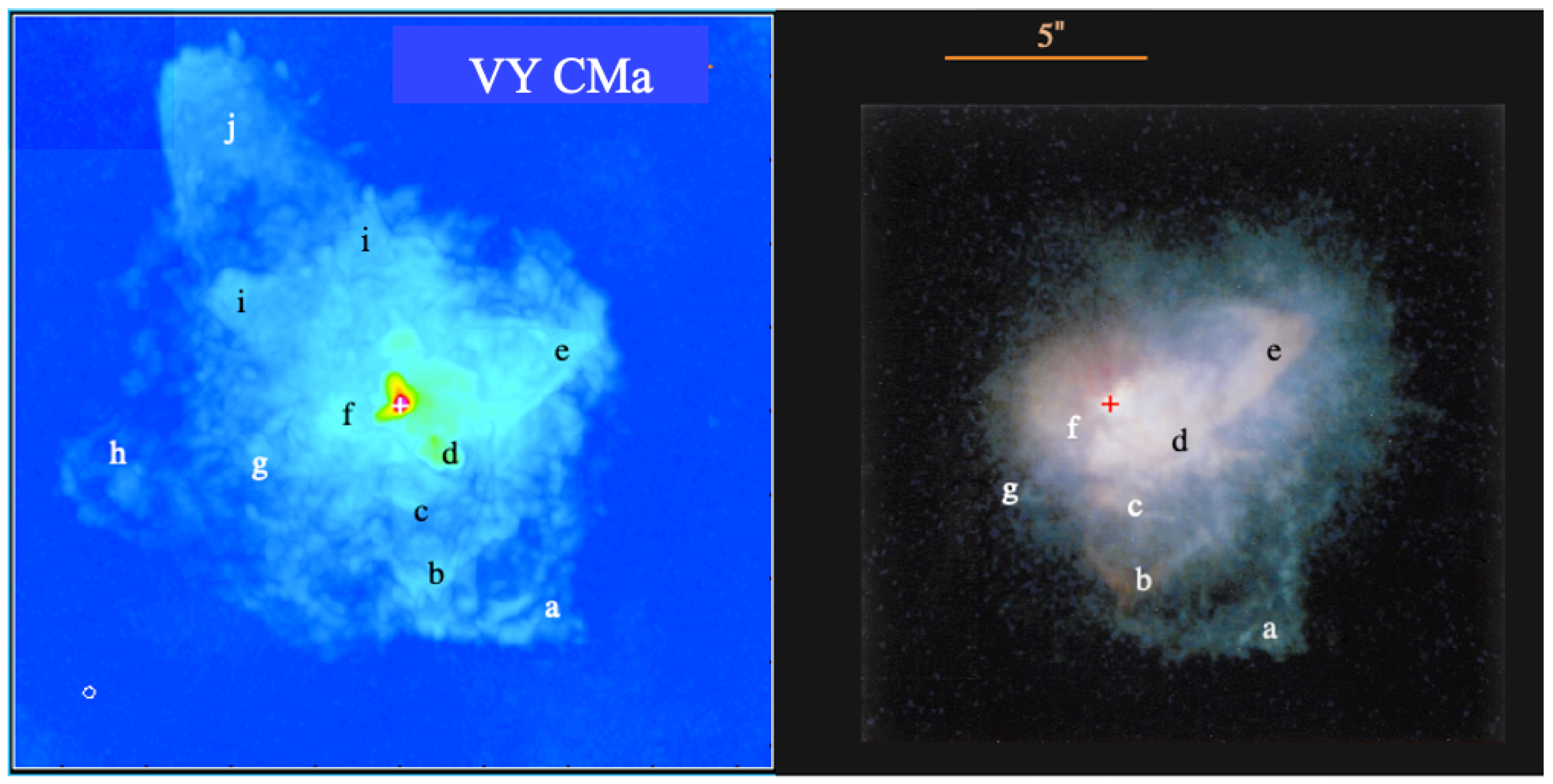
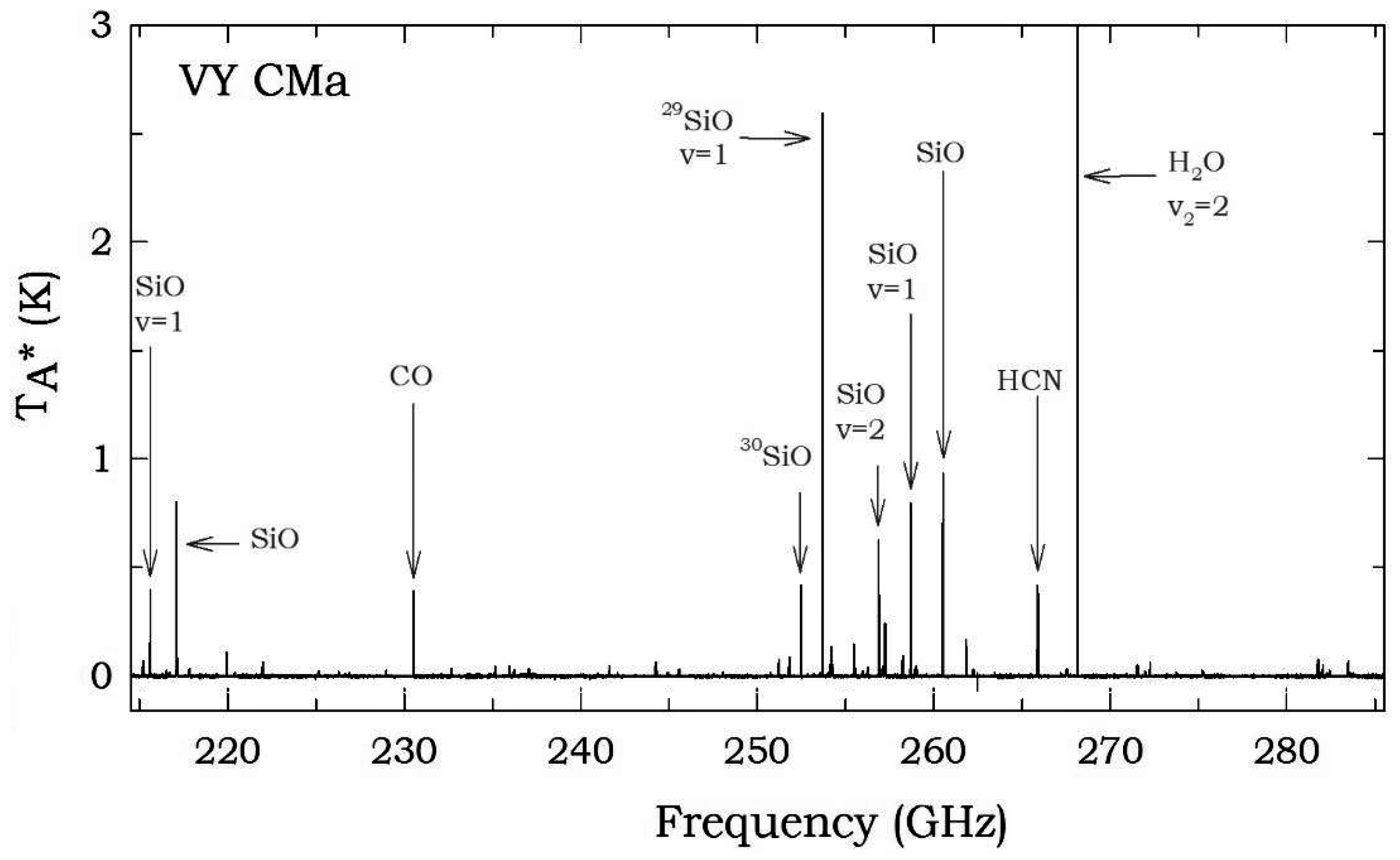
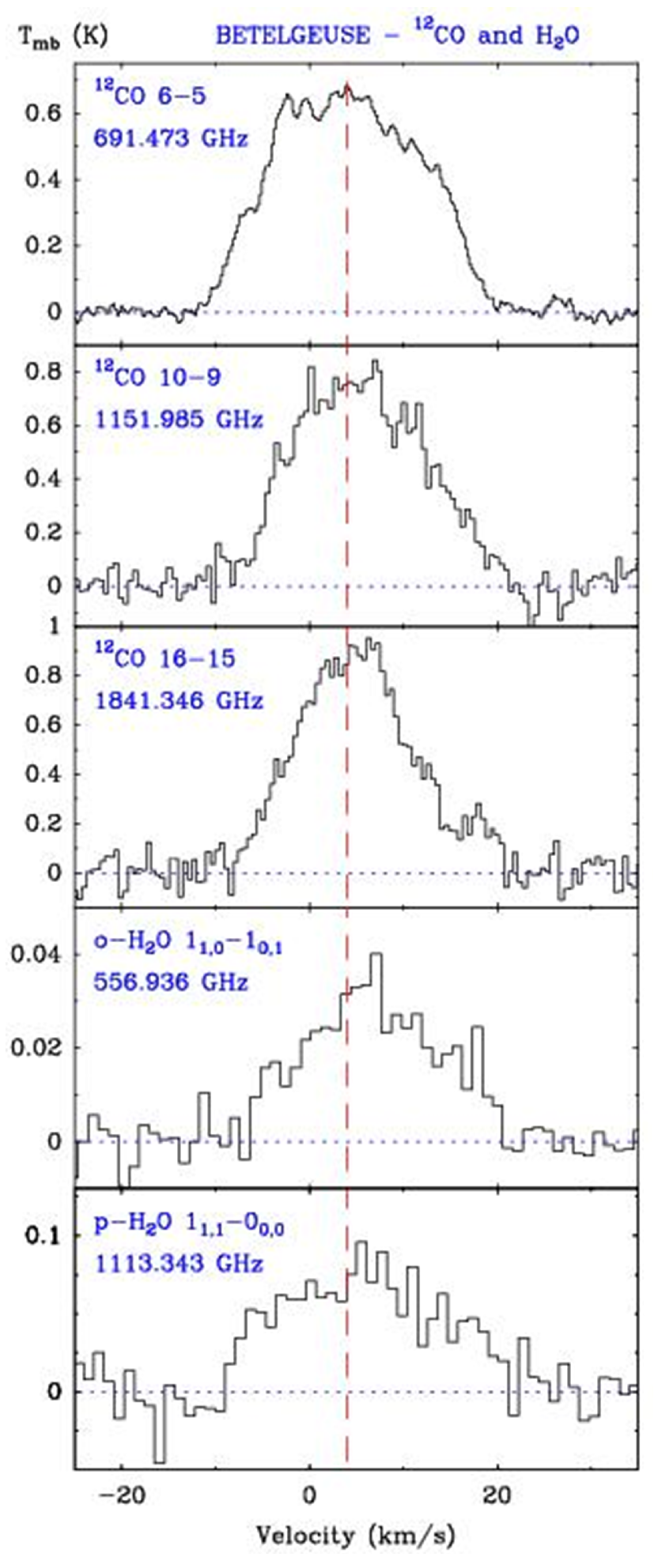


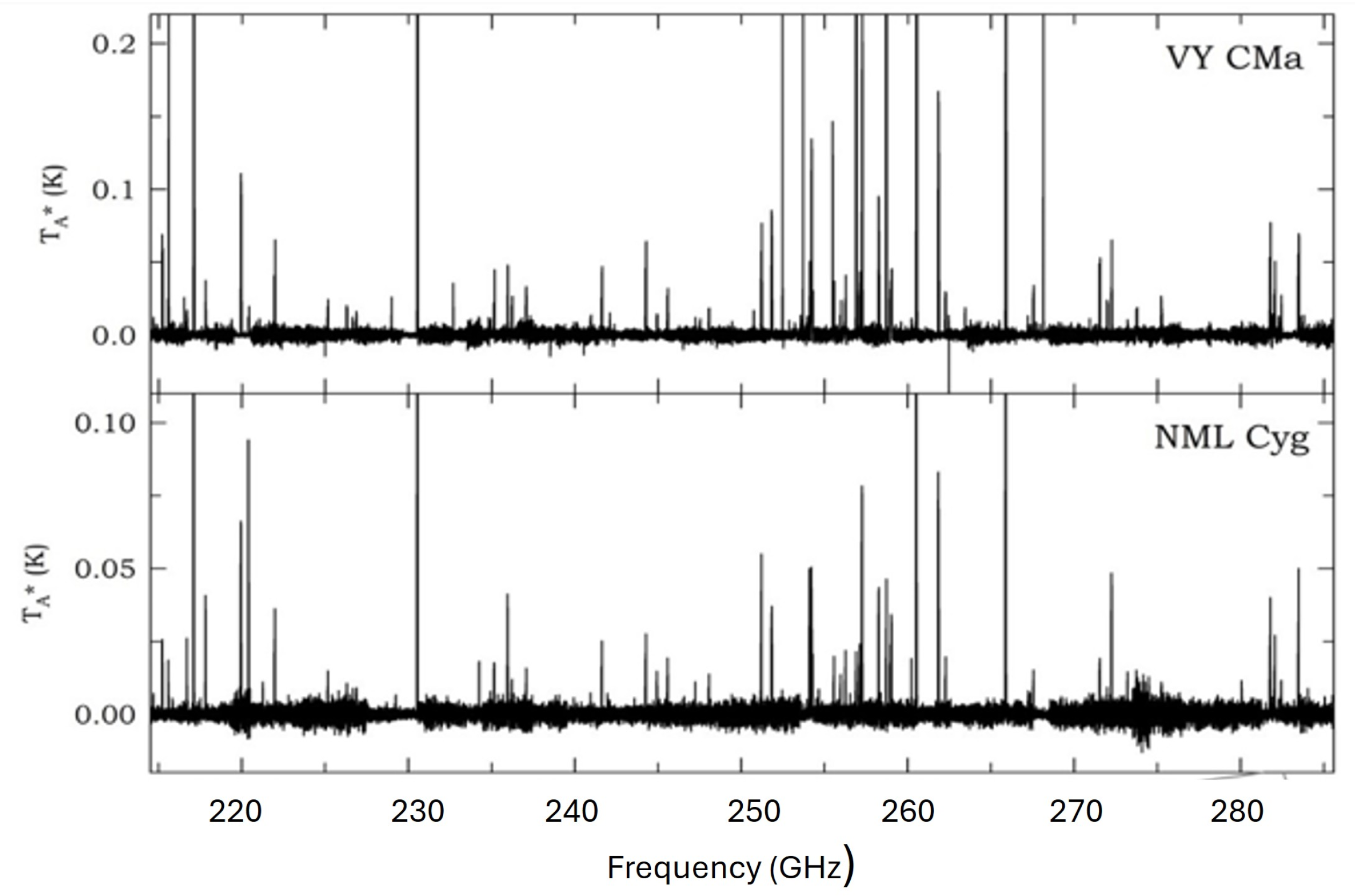
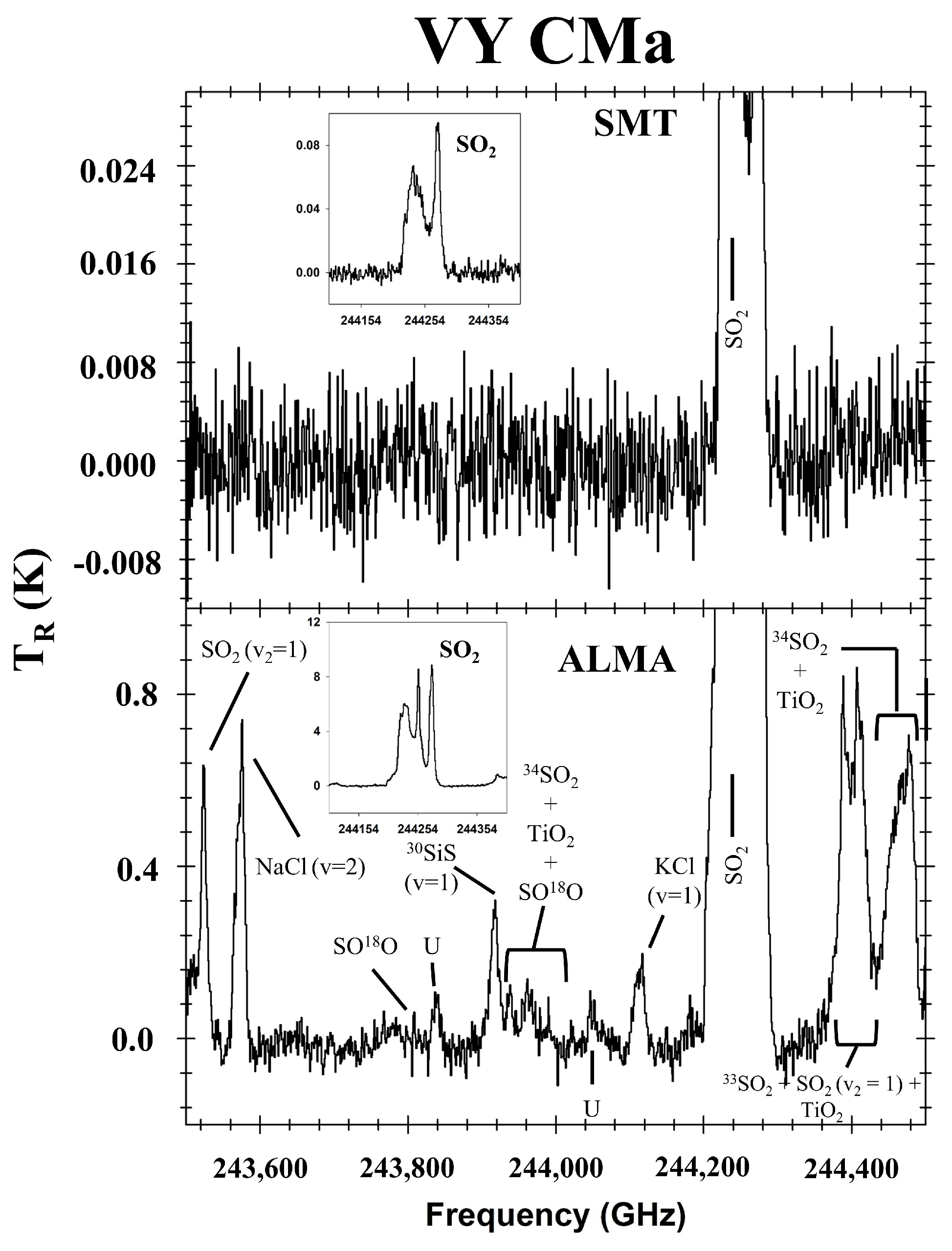

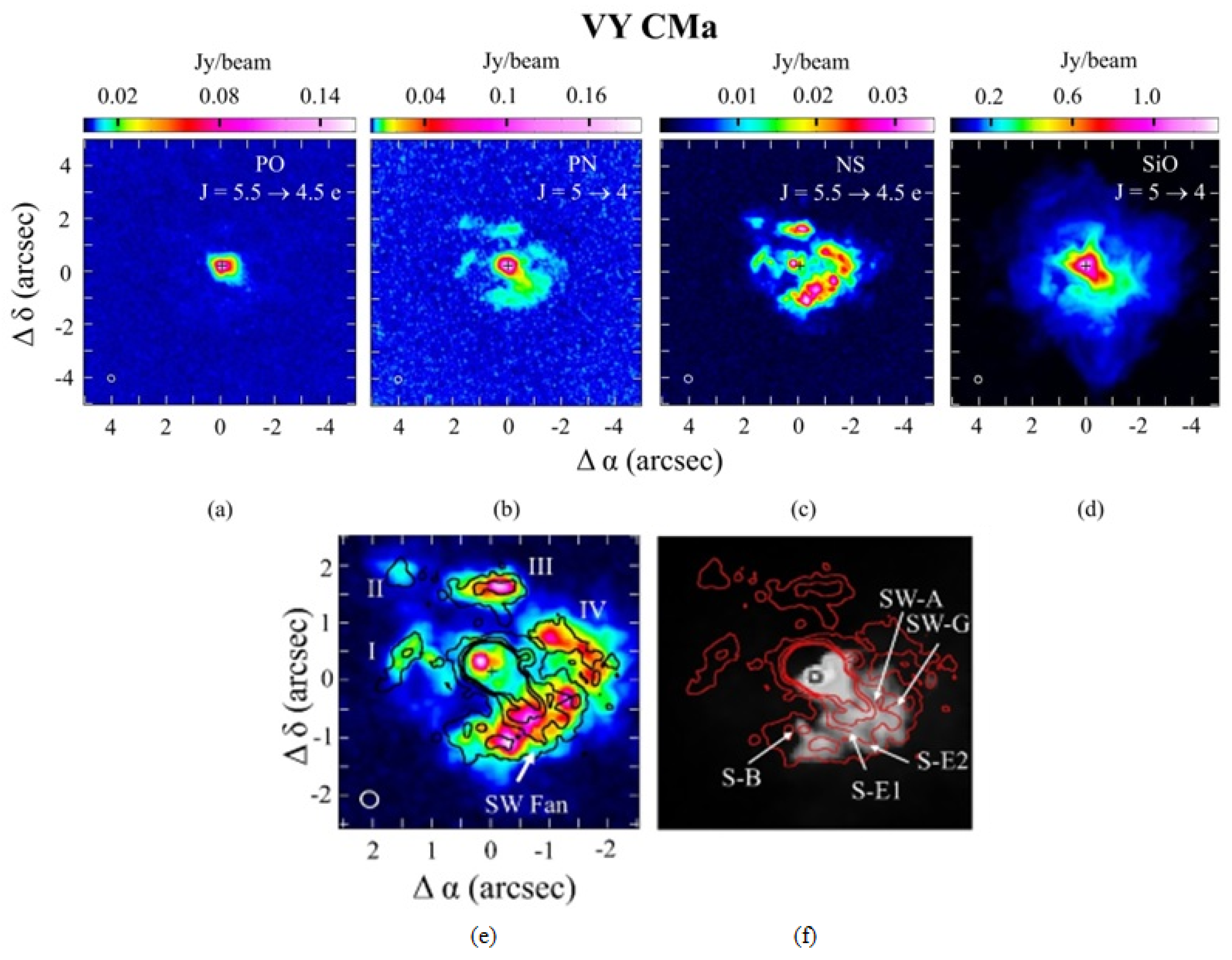


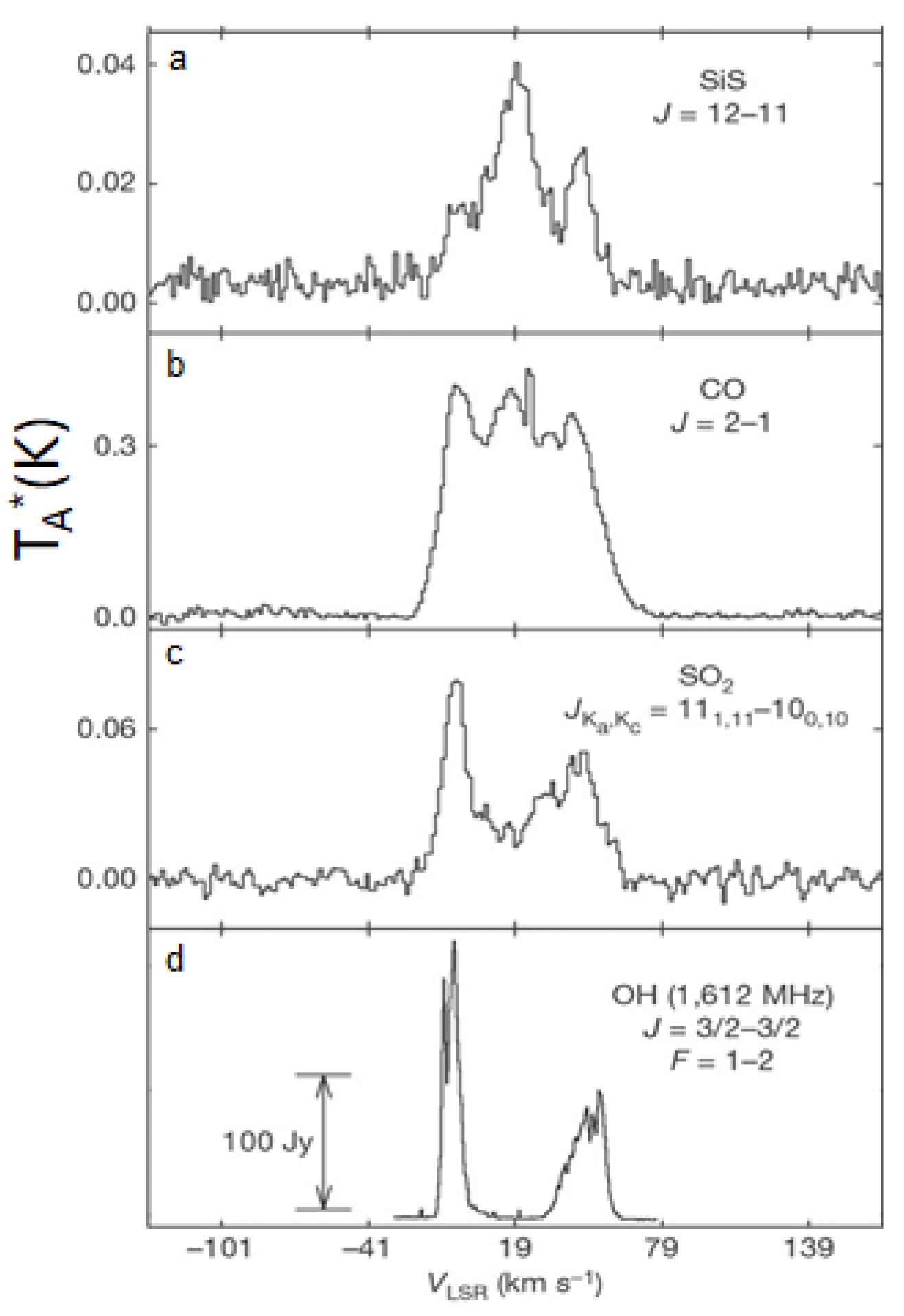

| Object | Mass () | Mass Loss Rate () | Envelope Structure | Molecular Content | Comments | Spectra |
|---|---|---|---|---|---|---|
| VY CMa a | 40 | Asymmetric; highly complex | Rich in metal oxides, halides, PO, PN | Red Hypergiant | Multiple blue-, red-shifted features | |
| NML Cyg b | 25 | Asymmetric | Rich in metal oxides, halides, PO, PN | Red Hypergiant | Multiple blue-, red-shifted features | |
| Betelgeuse c | 12–25 | Recent flares | CO, HCN, OH, O | RSG | Mostly symmetric h | |
| IRC+10420 d | 20 | g | Roughly spherical | N-rich, no “metal” species | Yellow Hypergiant | Symmetric |
| AH Sco e | 20 | Spherical | Metal oxides, AlF, PO | RSG | Broad and narrow features | |
| VX Sgr e | 12 | Spherical, shell-like | Metal oxides, AlF, PO | RSG | Symmetric, broad and narrow | |
| KW Sgr e | 20 | – | CO, HCN, SO | RSG | Weak | |
| S Per f | 30 | Spherical, some axial-symmetry | CO, O, OH i | RSG | – |
| HCN | SiO | PN | AlO | CO | SiS | PO | VO | ||
| CS | HNC | NaCl | AlOH | CN | O | SO | KCl | TiO | |
| NO | b | NS | AlCl | OH | S | AlF |
Disclaimer/Publisher’s Note: The statements, opinions and data contained in all publications are solely those of the individual author(s) and contributor(s) and not of MDPI and/or the editor(s). MDPI and/or the editor(s) disclaim responsibility for any injury to people or property resulting from any ideas, methods, instructions or products referred to in the content. |
© 2025 by the authors. Licensee MDPI, Basel, Switzerland. This article is an open access article distributed under the terms and conditions of the Creative Commons Attribution (CC BY) license (https://creativecommons.org/licenses/by/4.0/).
Share and Cite
Ziurys, L.M.; Richards, A.M.S. Molecules and Chemistry in Red Supergiants. Galaxies 2025, 13, 82. https://doi.org/10.3390/galaxies13040082
Ziurys LM, Richards AMS. Molecules and Chemistry in Red Supergiants. Galaxies. 2025; 13(4):82. https://doi.org/10.3390/galaxies13040082
Chicago/Turabian StyleZiurys, Lucy M., and Anita M. S. Richards. 2025. "Molecules and Chemistry in Red Supergiants" Galaxies 13, no. 4: 82. https://doi.org/10.3390/galaxies13040082
APA StyleZiurys, L. M., & Richards, A. M. S. (2025). Molecules and Chemistry in Red Supergiants. Galaxies, 13(4), 82. https://doi.org/10.3390/galaxies13040082






